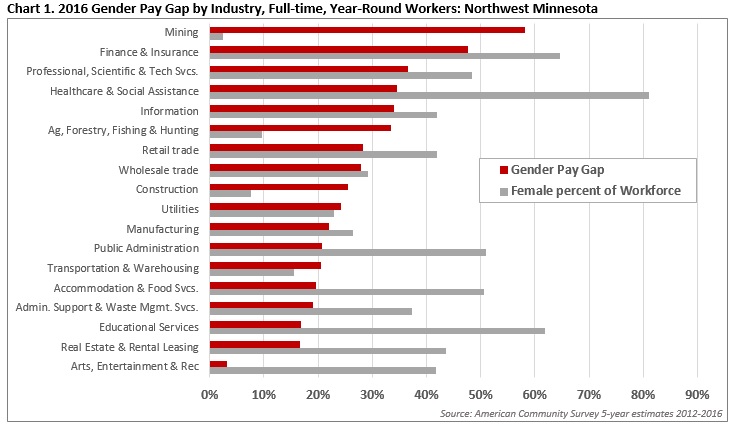 The presence of such industry powerhouses as Polaris, Arctic Cat and New Flyer make Northwest Minnesota a hub of transportation equipment manufacturing.
The presence of such industry powerhouses as Polaris, Arctic Cat and New Flyer make Northwest Minnesota a hub of transportation equipment manufacturing.
From wheat and potatoes to soybeans and sugar beets, the region is a major producer and processor of food staples and specialty agricultural products.
Want the freshest data delivered by email? Subscribe to our regional newsletters.
4/16/2018 12:04:56 PM
Chet Bodin
In 2018, the financial website WalletHub concluded that Minnesota is the best state for women to live and work, citing factors such as educational attainment, business ownership and rate of poverty. But despite the welcome accolades, an obstinate gender pay gap exists across the state.
According to data from the Census Bureau's American Community Survey (ACS), the unadjusted earnings ratio in Minnesota, or women's earnings as a percent of men's, was approximately 72 percent in 2016. By industry, the earnings ratio ranges from 51 percent in the agriculture, forestry, fishing and hunting sector to 89 percent in real estate, rental and leasing. Overall, the gender pay gap is even larger in Northwest Minnesota, where the earnings ratio was approximately 66.4 percent in 2016. There are many ways to examine the gender pay gap, however. Industry sector, hours worked, level of education, and occupation can each contribute to the gender pay gap, positively or negatively.
One factor often associated with the gender pay gap is the number of hours worked. Even if the pay is the same, one gender will earn more over the course of a pay period, or on an annual basis, if they work more hours. It should be noted, however, that the average number of hours worked can vary even among full-time employees. So while comparing the earnings of full-time, year-round workers provides a more accurate assessment of the gender pay gap than comparing overall earnings, it does not completely control for the number of hours worked.
Among full-time, year-round workers in Northwest Minnesota, a gender pay gap exists in every regional industry, although it varies from sector to sector. The Arts, Entertainment and Recreation industry had the smallest pay gap, where women earn approximately 97 percent of what men earn. On the other end of the spectrum, women earn only 42 percent of what men do in mining, where the pay gap is over 10 percent larger than in any other industry. The top three industries in terms of employment – Health Care and Social Assistance, Manufacturing, and Retail Trade – had the 4th, 11th and 7th largest gender pay gaps, respectively (Chart 1).

Perhaps unsurprisingly, the sector with the largest gender pay gap, mining, also had the smallest representation of women in the workforce. However, the relationship between workforce representation and the size of the gender pay gap is inconsistent across other industries. For example, less than 10 percent of workers in construction are women, but the industry's gender pay gap is less than half the size of that in mining. On the other hand, despite having a workforce that is nearly 65 percent female, finance and insurance has the second largest gender pay gap, as the median earnings of women in the industry are 48 percent lower than those of men in Northwest Minnesota.
Though women already fill just over half of the jobs in the region, data shows that a gender pay gap exists. Further progress toward closing the gender pay gap could effect change at multiple economic levels. It could be addressed to attract workers inside and outside the region and for employers competing in a tight labor market, taking steps toward equal pay may provide the edge needed to fill vacancies now and in the future.
Contact Chet Bodin.